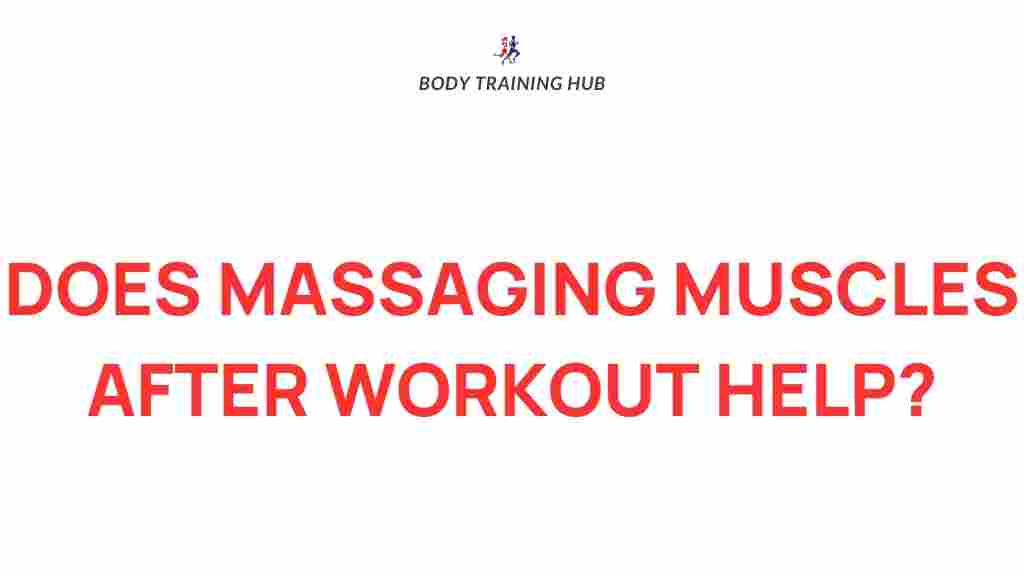Uncovering the Benefits of Post-Workout Muscle Massage for Muscle Recovery
After an intense workout, your body goes through a lot of changes. From muscle breakdown to lactic acid buildup, the aftermath of exercise can leave you feeling sore and fatigued. This is where muscle recovery becomes crucial, and one effective method for enhancing recovery is through massage therapy. In this article, we will explore the profound benefits of post-workout muscle massage, how it fits into your post-workout routine, and the overall exercise benefits it offers.
The Importance of Muscle Recovery
Muscle recovery is essential for everyone, whether you’re a casual gym-goer or a professional athlete. Proper recovery helps to rebuild muscle tissue, replenish energy stores, and reduce the risk of injury. Ignoring recovery can lead to prolonged muscle soreness and fatigue, hindering your performance in future workouts.
What is Massage Therapy?
Massage therapy involves manipulating the soft tissues of the body, including muscles, tendons, and ligaments, to promote relaxation and healing. Various techniques are used, such as:
- Swedish Massage: A gentle form of massage that uses long strokes and kneading.
- Deep Tissue Massage: Targets deeper layers of muscle and connective tissue.
- Sports Massage: Designed specifically for athletes to help prevent and treat injuries.
How Post-Workout Muscle Massage Aids in Muscle Recovery
Incorporating massage therapy into your post-workout routine can significantly enhance your muscle recovery process. Here are some key benefits:
1. Reduces Muscle Soreness
One of the most immediate benefits of massage therapy is its ability to alleviate muscle soreness, particularly delayed onset muscle soreness (DOMS), which often occurs 24 to 48 hours after exercise. By improving blood circulation and reducing inflammation, massage helps in:
- Decreasing the intensity of soreness.
- Enhancing the speed of recovery.
2. Improves Circulation
Massage therapy enhances blood flow to the muscles, which is essential for delivering nutrients and removing waste products like lactic acid. Improved circulation ensures that your muscles receive the necessary elements for optimal recovery. More oxygen and nutrients lead to:
- Faster healing of muscle tissues.
- Reduced fatigue and improved energy levels.
3. Enhances Flexibility
Regular post-workout massages can contribute to improved flexibility and range of motion. This is particularly beneficial for athletes and fitness enthusiasts who need to maintain peak performance. Increased flexibility can lead to:
- Better overall athletic performance.
- Lower risk of injuries.
4. Promotes Relaxation and Stress Relief
Massage therapy is well-known for its stress-relieving benefits. After an intense workout, taking the time for a massage helps to relax both the body and mind. This is important as stress can negatively impact recovery. Benefits include:
- Reduced levels of cortisol, the stress hormone.
- Enhanced mood and mental clarity.
5. Prevents Injuries
By addressing muscle tightness and imbalances, massage therapy can help prevent injuries. Regular massages help maintain muscle elasticity, reduce tension, and promote overall balance in the body. This proactive approach to injury prevention is crucial for:
- Athletes training for competitions.
- Individuals returning to exercise after a break.
Incorporating Massage Therapy into Your Post-Workout Routine
Now that we’ve uncovered the benefits, let’s discuss how to effectively incorporate massage therapy into your post-workout routine. Here’s a step-by-step guide:
Step 1: Hydrate After Your Workout
Before heading to your massage, ensure you hydrate adequately. Water is essential for flushing out toxins and supporting muscle recovery. Aim to drink:
- At least 16-20 oz of water after your workout.
- Additional fluids during the day to maintain hydration.
Step 2: Schedule Your Massage
Plan your massage session ideally within 24 hours after your workout. This timing maximizes the benefits of muscle recovery and helps alleviate soreness when it is most noticeable.
Step 3: Communicate with Your Massage Therapist
Before the session, discuss your workout routine and any specific areas of concern with your therapist. This will enable them to tailor the massage to your needs, focusing on areas that require more attention.
Step 4: Relax and Enjoy the Experience
During the massage, focus on relaxing your body and mind. Allow your therapist to work on your muscles, and try to breathe deeply to enhance the relaxation process. This will help in:
- Maximizing the effectiveness of the massage.
- Releasing tension and stress.
Step 5: Post-Massage Care
After your massage, continue to hydrate and consider doing some light stretching. This will further aid in your muscle recovery and help maintain flexibility. Listen to your body and allow it to rest as needed.
Troubleshooting Tips for a Better Massage Experience
To ensure you have the best possible experience with massage therapy, consider the following troubleshooting tips:
- Communicate discomfort: If you feel any pain during the massage, inform your therapist immediately. They can adjust their technique accordingly.
- Avoid heavy meals: Don’t eat a large meal right before your massage as it can cause discomfort. A light snack is fine.
- Dress comfortably: Wear comfortable clothing that allows easy access to areas being massaged, or opt for a professional massage setting where you can undress comfortably.
Conclusion
In summary, incorporating post-workout muscle massage into your routine is a highly beneficial practice for enhancing muscle recovery. The advantages of reducing muscle soreness, improving circulation, enhancing flexibility, promoting relaxation, and preventing injuries cannot be overstated. By following the steps outlined above, you can ensure that you are getting the most out of your massage therapy sessions.
Remember that every individual’s body is different, so listen to your body and adjust your post-workout routine accordingly. With consistent practice, you will not only enjoy the immediate benefits but also experience long-term improvements in your overall fitness journey.
For more information on exercise and recovery techniques, visit this helpful resource. And if you’re interested in learning more about massage types and techniques, check out this external link.
This article is in the category Strength & Recovery and created by BodyTraining Team

1 thought on “Uncovering the Benefits of Post-Workout Muscle Massage”